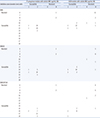1. Bergen PJ, Li J, Rayner CR, Nation RL. Colistin methanesulfonate is an inactive prodrug of colistin against
Pseudomonas aeruginosa. Antimicrob Agents Chemother. 2006; 50:1953–1958.


2. Stojanoski V, Sankaran B, Prasad BV, Poirel L, Nordmann P, Palzkill T. Structure of the catalytic domain of the colistin resistance enzyme MCR-1. BMC Biol. 2016; 14:81.

3. Falagas ME, Kasiakou SK. Colistin: the revival of polymyxins for the management of multidrug-resistant gram-negative bacterial infections. Clin Infect Dis. 2005; 40:1333–1341.


4. Gupta S, Govil D, Kakar PN, Prakash O, Arora D, Das S, et al. Colistin and polymyxin B: a re-emergence. Indian J Crit Care Med. 2009; 13:49–53.


5. Huang J, Tang YQ, Sun JY. Intravenous colistin sulfate: a rarely used form of polymyxin E for the treatment of severe multidrug-resistant Gram-negative bacterial infections. Scand J Infect Dis. 2010; 42:260–265.


6. Bosso JA, Liptak CA, Seilheimer DK, Harrison GM. Toxicity of colistin in cystic fibrosis patients. DICP. 1991; 25:1168–1170.


8. Suzuki T, Hayashi K, Fujikawa K, Tsukamoto K. The chemical structure of polymyxin E: the identities of polymyxin E1 with colistin A and of polymyxin E2 with colistin B. J Biochem. 1965; 57:226–227.


10. Yu Z, Qin W, Lin J, Fang S, Qiu J. Antibacterial mechanisms of polymyxin and bacterial resistance. Biomed Res Int. 2015; 2015:679109.

11. Bialvaei AZ, Samadi Kafil H. Colistin, mechanisms and prevalence of resistance. Curr Med Res Opin. 2015; 31:707–721.


12. de Louvois J. Factors influencing the assay of antimicrobial drugs in clinical samples by the agar plate diffusion method. J Antimicrob Chemother. 1982; 9:253–265.


13. Dafopoulou K, Zarkotou O, Dimitroulia E, Hadjichristodoulou C, Gennimata V, Pournaras S, et al. Comparative evaluation of colistin susceptibility testing methods among carbapenem-nonsusceptible
Klebsiella pneumoniae and
Acinetobacter baumannii clinical isolates. Antimicrob Agents Chemother. 2015; 59:4625–4630.


14. Balaji V, Jeremiah S, Baliga P. Polymyxins: antimicrobial susceptibility concerns and therapeutic options. Indian J Med Microbiol. 2011; 29:230–242.


15. Galani I, Kontopidou F, Souli M, Rekatsina PD, Koratzanis E, Deliolanis J, et al. Colistin susceptibility testing by Etest and disk diffusion methods. Int J Antimicrob Agents. 2008; 31:434–439.


16. Moskowitz SM, Ernst RK, Miller SI.
PmrAB, a two-component regulatory system of
Pseudomonas aeruginosa that modulates resistance to cationic antimicrobial peptides and addition of aminoarabinose to lipid A. J Bacteriol. 2004; 186:575–579.


17. Moskowitz SM, Garber E, Chen Y, Clock SA, Tabibi S, Miller AK, et al. Colistin susceptibility testing: evaluation of reliability for cystic fibrosis isolates of
Pseudomonas aeruginosa and
Stenotrophomonas maltophilia. J Antimicrob Chemother. 2010; 65:1416–1423.


18. Simar S, Sibley D, Ashcraft D, Pankey G. Colistin and polymyxin B minimal inhibitory concentrations determined by Etest found unreliable for gram-negative bacilli. Ochsner J. 2017; 17:239–242.


19. Tan T, Ng S. Comparison of Etest, Vitek and agar dilution for susceptibility testing of colistin. Clin Microbiol Infect. 2007; 13:541–544.


20. Bakthavatchalam YD, Veeraraghavan B. Challenges, issues and warnings from CLSI and EUCAST working group on Polymyxin susceptibility testing. J Clin Diagn Res. 2017; 11:DL03–DL04.

21. CLSI. Performance standards for antimicrobial susceptibility testing. 28th ed. CLSI supplement M100. Wayne, PA: Clinical and Laboratory Standards Institute;2018.
22. Humphries RM. Susceptibility testing of the polymyxins: where are we now? Pharmacotherapy. 2015; 35:22–27.


23. Turlej-Rogacka A, Xavier BB, Janssens L, Lammens C, Zarkotou O, Pournaras S, et al. Evaluation of colistin stability in agar and comparison of four methods for MIC testing of colistin. Eur J Clin Microbiol Infect Dis. 2018; 37:345–353.


24. Uyttendaele M, Debevere J. Evaluation of the antimicrobial activity of protamine. Food Microbiol. 1994; 11:417–427.









 PDF
PDF ePub
ePub Citation
Citation Print
Print



 XML Download
XML Download